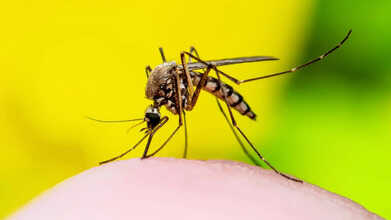- Health Conditions A-Z
- Health & Wellness
- Nutrition
- Fitness
- Health News
- Ayurveda
- Videos
- Medicine A-Z
- Parenting
- Web Stories
Not Sugar, Scientists Found A New Type Of Diabetes And It Is Linked To Malnutrition

Credits: Canva
For decades, diabetes has been broadly categorized into two main types: Type 1—an autoimmune disease often diagnosed in childhood, and Type 2—a metabolic disorder largely linked to obesity and lifestyle factors. But a quiet revolution in medical science has now brought to light a lesser-known, deeply complex third kind—Type 5 diabetes, a form of diabetes that has little to do with sugar or excess but everything to do with scarcity and deprivation.
Recently recognized by the International Diabetes Federation (IDF), Type 5 diabetes—also known as malnutrition-related diabetes—marks a pivotal shift in how the world understands and approaches diabetes, especially in vulnerable populations.
What Is Type 5 Diabetes?
Malnutrition-related diabetes isn’t new. In fact, it was first identified in 1955 in Jamaica and later seen in impoverished communities in India, Pakistan, and parts of sub-Saharan Africa. Known initially as “J-type diabetes,” it primarily affects young, thin, and malnourished teenagers and young adults, often in low- and middle-income countries.
The World Health Organization (WHO) even acknowledged it as a distinct form of diabetes in 1985—only to quietly remove the classification in 1999 due to insufficient research. This decision led to decades of diagnostic ambiguity and a lack of targeted care for millions.
Fast forward to 2025, and this long-overlooked condition has officially been given a name and a place in global diabetes taxonomy—thanks to the tireless advocacy of Dr. Meredith Hawkins, Professor of Medicine and Founding Director of the Global Diabetes Institute at Albert Einstein College of Medicine in New York.
How is Type 5 Diabetes Different From Type 1 And Type 2?
While Type 1 diabetes involves an immune attack on insulin-producing cells and Type 2 typically arises from insulin resistance due to obesity, Type 5 diabetes is mechanistically different. It’s not caused by sugar overload or autoimmunity—but by chronic undernourishment.
Dr. Hawkins explains, “People with this form of diabetes have a profound defect in their capacity to secrete insulin—a discovery that rewrites the medical script on how we diagnose and treat it.”
Earlier assumptions suggested that this form of diabetes was a variant of Type 2 due to perceived insulin resistance. But landmark studies, including a 2022 collaboration between Einstein’s Global Diabetes Institute and Christian Medical College in Vellore, India, confirmed a radically different pathology.
It’s estimated that 20 to 25 million people globally live with Type 5 diabetes, primarily across Asia and Africa. Yet, it has remained one of the least diagnosed and most poorly understood forms of the disease.
What’s alarming is that many patients do not survive more than a year after diagnosis—not necessarily due to the disease itself, but because the lack of proper classification has prevented the development of effective treatment protocols. Inappropriate use of insulin can cause life-threatening hypoglycemia, as these patients do not respond to insulin the way those with Type 1 do.
Dr. Hawkins compares the prevalence of Type 5 diabetes to major global health issues: “It’s more common than tuberculosis and nearly as common as HIV/AIDS in certain regions, yet it has remained invisible in global health policy.”
The IDF’s official recognition of Type 5 diabetes is more than symbolic—it is the beginning of a strategic, scientific, and humanitarian effort to right a historic wrong. A dedicated working group has been established to lead the way, with three core objectives:
Develop standardized diagnostic and treatment guidelines tailored to malnutrition-related diabetes
Create a global patient registry to enable data collection, longitudinal studies, and targeted interventions
Launch educational modules and awareness campaigns for healthcare professionals worldwide
These initiatives aim to bridge the gap between scientific knowledge and real-world practice—especially in underserved regions where Type 5 diabetes continues to silently claim lives.
Malnutrition-related diabetes, by contrast, has remained unnamed, affecting those with the least access to quality care, diagnostics, and therapies. Dr. Hawkins’ work is a reminder that health systems must be attuned to the full spectrum of human experience—not just the diseases of excess, but also those of scarcity.
“It’s not just about having a name,” says Dr. Hawkins. “It’s about making sure that young lives aren’t lost to a treatable condition simply because we weren’t looking.”
New York Reports First Local Case Of Chikungunya Virus; Watch For This Unique Symptom

Credits: Canva
A resident of New York has tested positive for the chikungunya virus, marking the first local transmission of the mosquito-borne illness in the United States in six years, according to state health officials. The New York State Department of Health confirmed Tuesday that the case was detected in a person from Nassau County, Long Island.
The county’s health department stated that the individual began showing symptoms in August after traveling outside the region but not leaving the country. Officials have not disclosed the person’s identity or the exact source of infection.
What Is Chikungunya?
Chikungunya (CHIKV) is a viral disease spread to humans through the bites of infected mosquitoes, primarily Aedes aegypti and Aedes albopictus. Infection occurs when a mosquito carrying the virus bites a person. It does not spread from one person to another through touch, saliva, or airborne particles, although transmission through blood is possible in rare cases.
The illness is known for causing high fever and severe joint pain, often intense enough to affect mobility. The name “chikungunya” originates from a word meaning “that which bends up,” describing the stooped posture people often develop due to the pain. There is currently no antiviral treatment for the infection, and care mainly focuses on relieving symptoms. Most individuals recover within a week, though some experience lingering joint discomfort for weeks or months.
What Are The Symptoms Of Chikungunya?
Symptoms typically appear three to seven days after an infected mosquito bite, though in some cases they can develop as early as two days or as late as 12. The most common symptoms are fever and joint pain, which may be mild for some but extremely painful for others. The fever often starts suddenly, and some people mistake their symptoms for another illness or may not seek medical attention.
Other signs of chikungunya include:
- Headache
- Muscle aches
- Joint swelling
- Rash
- Fatigue
- Nausea
Is Chikungunya Contagious?
The virus spreads only through the bite of an infected mosquito. A person with chikungunya cannot pass the virus directly to another person through saliva, touch, or respiratory droplets. The risk of transmission to another mosquito is highest during the first week of symptoms, when the virus is present in the blood.
While New York has recorded three other cases of chikungunya earlier this year, all were linked to international travel. Local mosquitoes, however, are capable of carrying and spreading other viruses such as West Nile, Eastern Equine Encephalitis, and Jamestown Canyon virus.
Times Now Network Ranks India’s Top Hospitals, Survey Reveals Performance Across 16 Cities

Credits: Canva
Times Now Network conducted a survey where different hospital chains were ranked to understand how well the hospitals and healthcare institutions in India work and if the services offered by them adhere to the benchmarks given by NABH, under the Quality council of India.
The parameters on which these hospitals were judged were VFM or value for money, quality of treatment, team of consultants and doctors, infrastructure, hygiene and cleanliness, faculties and public convenience, and innovation and research facilities. The factual scores were submitted by the institutions and held 60% weightage, while the perceptual scores held a weightage of 40% weightage.
The institutes were asked to submit details and information including verification and validation by a research agency. The scores were also based on the perceptual survey, with a sample size of 3000, conducted across 16 cities, and then the final scores were calculated based on the weightages of the different parameters. Word of mouth is also considered in the survey as it holds a critical point in decision making. The results were announced in the latest India Health Summit, held at Taj Palace, Delhi on October 4, 2025.
The Ranks Are As Followed

The survey covered various critical care specialties, including cardiology, neurology, nephrology, oncology, obstetrics and gynecology, pediatrics, urology, gastroenterology, and emergency and trauma. Among the lifestyle categories were dental health, orthopedics, diabetes care, IVF & fertility, and cosmetic and plastic surgery.
The sample size was across 12 cities, which included 3300 doctors and patients with the ratio of 40:60. It was as followed:
- Delhi NCR had a sample size of 300
- Mumbai had a sample size of 300
- Chennai had a sample size of 300
- Kolkata had a sample size of 300
- Bengaluru had a sample size of 300
- Hyderabad had a sample size of 300
- Ahmedabad had a sample size of 250
- Pune had a sample size of 250
- Bhubaneswar had a sample size of 250
- Jaipur had a sample size of 250
- Lucknow had a sample size of 250
- Kochi had a sample size of 250
In addition to this, for Factual Survey, over 1500 hospitals across India were targeted and connected.
The main objective of this survey was to provide clarity that usually lacks in other ranking as they do not detail out on how the hospitals is performing better than others and on what parameters and hence it is difficult for patients to take an informed decision.
Kristen Storms, General Hospital Star Opens Up About Her Brain Aneurysm

Credits: Instagram @kirstenstorms
"My brain seems to be sorta lowkey rebelling against me," says the General Hospital star Kristen Storms who revealed that she will soon be undergoing a surgery to treat her brain aneurysm.
The 41-year-old ABC soap opera star on October 14 shared her healthy journey in a candid Instagram post, revealing that she had discovered about her condition in a recent medical scan.
A New Discovery During A Typical Scan
She explained that while doing a follow-up scan for the cyst she had removed from her brain in 2021, she discovered aneurysm on the right side. “While undergoing a follow-up scan for the cyst, my neurosurgeon discovered an aneurysm on the right side,” she wrote.
In January, she underwent a procedure in which doctors threaded a tiny camera from her leg up to her brain, a process she humorously described as “insane.” “It’s a routine procedure, but the path inside your body that they lead the camera through is wild,” she said. “THE CAMERA GOES THROUGH YOUR ARMPIT, guys. Your. Armpit.”
However, due to the complexity of her case, the doctors did not perform the surgery.
What Is Coiling? How Does It Treat Brain Aneurysm?
A brain aneurysm is a weak, bulging area on the wall of a blood vessel in the brain that can resemble a balloon or blister. Most brain aneurysms cause no symptoms until they rupture, which can lead to a life-threatening hemorrhage (bleeding) called a subarachnoid hemorrhage (SAH). Rupture can result in stroke, brain damage, coma, or death, making a ruptured aneurysm a medical emergency that requires immediate treatment.
According to Johns Hopkins Medicine, coiling is a minimally invasive procedure used to block blood flow to an aneurysm. By placing soft platinum coils, which are thinner than a strand of hair, into the bulging artery, doctors can prevent it from rupturing. If left untreated, a burst aneurysm can lead to brain damage or even be fatal.
Storms shared that her coiling procedure is now being scheduled within the next two weeks. To calm her nerves while she waits, she’s been spending time with her close friend and former co-star Emme Rylan (who played Lulu on General Hospital), “crocheting the most beautiful sweaters,” as she put it.
A Life Changing Moment
"Aneurysms (obviously) can be caused by stress. It was clear I needed to change some things in my life asap. For my own personal reasons, no longer living in Los Angeles was very important to me. The biggest reason was Harper, but also for my physical and mental health. And my overall happiness," she wrote.
Earlier this year, Storms took a break from General Hospital and relocated to Nashville with her 11-year-old daughter, Harper.
In her post she also addressed false rumor around her hospital visits when someone had spread a rumor that Storms was hospitalized for a suicide attempt. "I couldn’t understand why a person would make up something that terrible when they had no idea why I was really there,” she said.
However, despite all this, she keeps a positive and a hopeful attitude, which also showed in her message that read: “There are a few really bad apples out there. But there are people in my life who I am truly thankful to know. One of those individuals just made a sh*t load of sweaters with me. They are glorious.”
She ended the note with: "“Even though my brain seems to be sorta lowkey rebelling against me, we’ve all got times when things aren’t great. If we can, we’ll do our best for ourselves and our loved ones.”
© 2024 Bennett, Coleman & Company Limited

